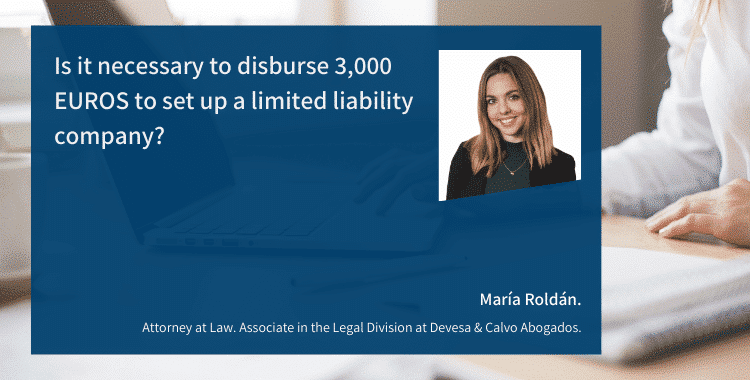
Is it necessary to disburse 3,000 EUROS to set up a limited liability company?
Without prejudice to the possibility of not providing proof of the reality of the contributions in Limited Liability Companies in accordance with art. 62. 2 of Article 62 of the Consolidated Text of the Capital Companies Act – a matter that was already dealt with in a previous post – the fact is that the law has created a type of company – or rather a “sub-type”, as will be discussed below – that allows shareholders interested in setting up a Limited Liability Company to avoid having to make any kind of minimum payment, as this type of company does not require the contribution of minimum share capital.
Thus, following the entry into force of Law 14/2013, of the 27th of September, on support for entrepreneurs and their internationalisation, a new path has been opened up for entrepreneurs who wish to set up a Limited Liability Company. That is to say, although before this Law only the late payment of part of the share capital was allowed in Public Limited Companies (passive shares), with it, a new corporate sub-type is created: the Successive Formation Limited Liability Company (SFLLC).
Article 4.bis 3) of Royal Legislative Decree 1/2010, of the 2nd of July, which approves the revised text of the Capital Companies Act:
“It shall not be necessary to prove the reality of the monetary contributions of the partners in the incorporation of successively formed limited liability companies. The founders and those who acquire any of the shares assumed in the constitution shall be jointly and severally liable to the company and the company’s creditors for the reality of these contributions”.
The legal regime of this new sub-type of company is practically identical to that envisaged for Limited Liability Companies, with the main difference being that it is not necessary to contribute a minimum share capital (in SLs a minimum of 3,000 EUROS is required), as well as the requirement to comply with certain obligations and limitations aimed at guaranteeing the protection of third parties in their financial, labour and commercial relations. These obligations, which are characteristic of the SFLLCS, are provided for in Article 12 of the aforementioned Law on support for entrepreneurs and their internationalisation, which partially amends the Consolidated Text of the Capital Companies Act to give legal cohesion to both clauses:
- A figure at least equal to 20 percent of the profit for the year must be allocated to the legal reserve, with no amount limit.
- Once the legal or statutory provisions have been covered, shares may only be distributed to the shareholders if the value of the net assets is not less than 60 per cent of the minimum legal capital or, as a result of the distribution, is not less than 60 per cent of the minimum legal capital.
- The annual sum of the remuneration paid to shareholders and directors for the performance of their functions during the financial years may not exceed 20 per cent of the net assets for the financial year, without prejudice to the remuneration to which they may be entitled as employees of the company or through the provision of professional services which the company itself arranges with such shareholders and directors.
- In the event of voluntary or compulsory liquidation, if the company’s assets are insufficient to meet the payment of its obligations, the shareholders and directors of the company shall be jointly and severally liable for the payment of the minimum amount of capital established by law.
- In addition to the information required for any type of capital company, the Articles of Association must expressly state that the company is subject to the regime laid down for SFLLCs. Furthermore, Mercantile Registrars shall, ex officio, state this circumstance in the dispatch notes of any registrable document relating to the company, as well as in the certificates they issue.
Concluding, we can indicate that SFLLCs are a sub-type of Limited Liability Companies, i.e. a transitional regime that entrepreneurs may use depending on their circumstances, foreseen for those companies that plan to become Limited Liability Companies in the future, once the partners have voluntarily (and even gradually) contributed the minimum share capital that is legally established for this type of company. In the meantime, the SFLLC will be subject to compliance with certain requirements and obligations, which do nothing more than try to provide guarantees so that this type of company will be able to grow through self-financing. And it is precisely because of the limitations imposed by its legal regime that this formula has practically fallen into disuse following the amendment of Art. 62.2 of the Consolidated Text of the Capital Companies Act, which offers the founding shareholders an additional possibility of not accrediting the reality of the contributions to the share capital and which, in practice, is the formula chosen by entrepreneurs.
If the reader is interested in further information on this matter, we recommend reading the post that has been referred to since the beginning: https://www.devesa.law/la-acreditacion-de-la-realidad-de-las-aportaciones-sociales-en-las-s-l/
Attorney at Law. Associate in the Legal Division at Devesa & Calvo Abogados.
